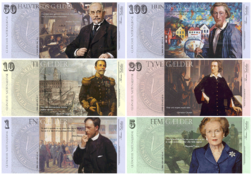Glanish currency
This article is incomplete because it is pending further input from participants, or it is a work-in-progress by one author. Please comment on this article's talk page to share your input, comments and questions. Note: To contribute to this article, you may need to seek help from the author(s) of this page. |
| Glanish currency | |
|---|---|
 Glanish gilder (gælder) | |
| ISO 4217 | |
| Code | SGG |
| Denominations | |
| Subunit | |
| 1/100 | øre |
| Plural | gilder |
| øre | øre |
| Symbol | ₲ |
| Banknotes | ₲1, ₲5, ₲10, ₲20, ₲50, ₲100, ₲500, ₲1000, ₲5000 |
| Coins | 10c, 25c, 50c (₲ 1⁄10, ₲ 1⁄4, ₲ 1⁄2) |
| Demographics | |
| User(s) | |
| Issuance | |
| Central bank | National Reserve Bank of Glanodel (Vænholms Bank) |
| Valuation | |
| Inflation | 0.7% |
| Source | November 2017 |
The gilder (or gælder in Lhedwinic; Glanish pronunciation: [GILL-DER]; plural: gælder; sign: ₲; code: SGG) is the currency of Glanodel. It is subdivided into 100 øre (singular: øre). The smallest denomination currently produced is the 10 øre coin (or 10 cent coin), but the øre remains the smallest unit of account. The word gælder is based on the Old Lhedwinic word (spelled and pronounced the same) which directly translated to "debt" or "to owe" and was chosen by the majority of Glanish banks to refer to the first banknotes produced in Glanodel.
The gilder is traded globally and has historically been a reliable and consistent store of value. This is generally attributed to its reliable purchasing power, steady and low inflation rate, the political and financial stability of Glanodel, and the central bank's consistent and investor-friendly monetary policies. As a result, the gilder is often described by financial news as a hard currency. In October of 2017, the gilder was the 5th most traded currency in the world by value and accounted for 2.6% of the world's non-gold foreign exchange reserves.